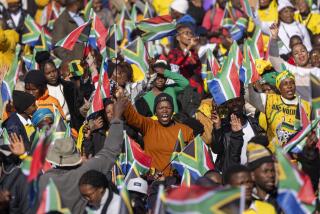South Africa Without Apartheid: DISMANTLING RACIAL DOMINATION by Heribert Adam and Kogila Moodley (University of California: $18.95; 315 pp.)
Books about South Africa keep coming: The work under review is No. 39 in the University of California Press’ “Perspectives on Southern Africa” series. Heribert Adam’s “Modernizing Racial Domination” (1971) was No. 2--which gives some idea of the writings on the subject brought out by a single scholarly publishing house.
Adam is a German sociologist teaching at Simon Frazer University in Vancouver. Kogila Moodley, his wife and co-author, is a former South African of Indian descent who teaches at the University of British Columbia.
They are optimists. “There are reasons to hope for a more peaceful resolution in South Africa than in other divided societies,” they believe. The South African struggle is not over ideology or creeds (as in the Middle East) but about power and privilege, and the competing groups are to a great extent economically interdependent: Blacks and whites need one another. Moreover, “an ethnic technocracy has begun to perceive the rising costs of apartheid domination and is engaged in modifying its control through reform.”
There are, alas, forces that seek to prevent this happy outcome: Marxist extremists (linked here with the Black Consciousness movement and the Azanian People’s Organization) and Afrikaner neo-Nazis (who regard P. W. Botha as a dangerous liberal). Between them, these fanatics are liable to polarize the conflict and make racial rapprochement impossible.
Luckily, however, according to Adam and Moodley, the African National Congress stands in the way of disaster. What’s more, they feel, “the ANC option” should be “attractive to business”--for one thing, “the ANC could be expected to restore order in the townships . . . (And) hold in check the growing anti-capitalist ‘ultra-leftist elements’ (AZAPO, etc.). Since these tasks will probably involve strong-arm tactics rather than gentle democratic persuasion, business is unlikely to be much concerned about civil rights violations under the new regime.”
Adam and Moodley would thus appear to see the ANC as the South African establishment’s last line of defense. “Ironically, it may turn out to be the great historical mission of the ANC to contain the anomie (lawlessness) rather than instigate revolutionary destruction,” they say. Though this agenda may raise cheers at the Chamber of Commerce, one can but wonder what the rebels in the townships would make of it. I certainly hope it will be communicated to them before the revolution.
The authors have been badly instructed in the history of democratic struggle in South Africa. “Congress (i.e., the racially organized umbrella movement of which the ANC became a component after the communist takeover of the organization in the 1950s) has always pursued an explicitly nonracial policy,” they tell us. In fact, the call for a nonracial policy (which was taken up by the South African Liberal Party) evolved precisely in rejection of Congress multiracialism. This is a significant “mistake,” because Adam and Moodley recognize the importance of nonracial policy in bringing about democratic change. And elsewhere in their own book, they note that “the many socialist critics of the Congress alliance have pointed out” that “its very principle of organization corresponds to the official race classification.”
Adam and Moodley seem confused in more than one sense. “South Africa Without Apartheid” veers from apparent approval of capitalism and a market economy to yearning for “true social democracy.” The book’s great virtue is that it sets out to combat the deadly reductionism so popular among neo-Marxist academics. But the authors constantly lapse into Marxist jive themselves. You get the impression that they have not actually thought much about the meaning of the words they use. In the Cultural Revolution, they assert, for example, “Mao used organized youngsters to terrorize his bourgeois opponents” (emphasis added). Try telling them that in Peking!
The authors admit that the ANC is “Moscow-linked,” but argue that it is “prudent for Moscow to let South Africa fester as the obvious racial sore of capitalism. . . . With relatively small expenditures for military hardware and diplomatic assistance, the Soviet Union reaps huge ideological benefits in public opinion from the Western ties with a colonial racist regime. . . . The Kremlin would be an unlikely source for active disturbance of the apartheid order.” Unfortunately, the authors fail to follow through on the implications of this, though they do provide a hint: “The ANC’s controversial strategy was to attack where its opponent was strongest and the ANC weakest,” we are told, with no explanation of why such a peculiar strategy should have been adopted. The reason is simple: The “struggle” is theater, for the beguilement of world audiences. The import of the “controversial strategy” is to send young men to die in a spasmodic and uncoordinated attack on superior force; the ANC then “takes credit” (as they say on the nightly news). The pot has been kept boiling like this for more than a quarter century now. Nelson Mandela himself was an early sacrifice.
There is a real struggle going on in South Africa, of course, but it is not being waged by the ANC’s “External Mission.” Rather, it is the struggle of millions of ordinary people (many of whom cling in blind desperation to the myth of the ANC) to survive under the pitiless sun of apartheid--to survive and perhaps, notwithstanding state terrorism and self-serving politicians, to do more and gain a modicum of freedom.
How nonracial democracy might now be achieved is unclear. The future seems to hold out the prospect of an isolated “fortress South Africa” with ever-increasing repression. Neither the “American model” nor the “Brazilian model” of South Africa’s future seems likely to be realized soon: Perhaps the country will instead gradually decline into a sort of “Albanian model” of subsistence fascism, with the state gradually engulfing more and more of society. (This is not as far-fetched as it may sound: With its huge parastatal corporations, the South African economy is already “socialized” to a very considerable extent: About 35% of all employed whites and 20% of nonwhites work for the state.)
The useful discussion this book contains is frequently so mired in jargon that it is hard to envisage a general readership. Portentous statements turn out when analyzed to say little or nothing: “Ethnic consciousness always exists within some specific sociopolitical context,” we are told. Yes, and apples always grow on trees. Documentation is frequently defective and sometimes missing entirely. “British empire-builders in the 19th Century considered Afrikaners as ‘prefabricated collaborators’,” it is claimed, for example--but there is no source given for this historically improbable term, which becomes more than a little suspect when one realizes that the word prefabricate did not come into use until the 1930s.
Ah well. Perhaps 10 years from now, Adam and Moodley will have another shot at explaining South Africa to us. What will it be this time? “Renovating Racial Domination”?
More to Read
Sign up for our Book Club newsletter
Get the latest news, events and more from the Los Angeles Times Book Club, and help us get L.A. reading and talking.
You may occasionally receive promotional content from the Los Angeles Times.










